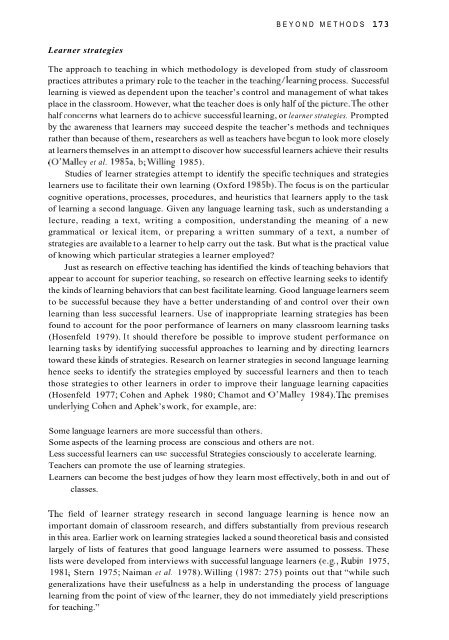English Language Teaching in its Social Context
English Language Teaching in its Social Context
English Language Teaching in its Social Context
Create successful ePaper yourself
Turn your PDF publications into a flip-book with our unique Google optimized e-Paper software.
BEYOND METHODS 173Learner strategiesThe approach to teach<strong>in</strong>g <strong>in</strong> which methodology is developed from study of classroompractices attributes a primary role to the teacher <strong>in</strong> the teach<strong>in</strong>g/learn<strong>in</strong>g process. Successfullearn<strong>in</strong>g is viewed as dependent upon the teacher’s control and management of what takesplace <strong>in</strong> the classroom. However, what the teacher does is only half ofthe picturc.The otherhalf conccrns what learners do to achieve successful learn<strong>in</strong>g, or learner strategies. Promptedby the awareness that learners may succeed despite the teacher’s methods and techniquesrather than because of them, researchers as well as teachers have begun to look more closelyat learners themselves <strong>in</strong> an attempt to discover how successful learners acheve their results(O’Malley et al. 1985a, b;Will<strong>in</strong>g 1985).Studies of learner strategies attempt to identify the specific techniques and strategieslearners use to facilitate their own learn<strong>in</strong>g (Oxford 1985b).The focus is on the particularcognitive operations, processes, procedures, and heuristics that learners apply to the taskof learn<strong>in</strong>g a second language. Given any language learn<strong>in</strong>g task, such as understand<strong>in</strong>g alecture, read<strong>in</strong>g a text, writ<strong>in</strong>g a composition, understand<strong>in</strong>g the mean<strong>in</strong>g of a newgrammatical or lexical item, or prepar<strong>in</strong>g a written summary of a text, a number ofstrategies are available to a learner to help carry out the task. But what is the practical valueof know<strong>in</strong>g which particular strategies a learner employed?Just as research on effective teach<strong>in</strong>g has identified the k<strong>in</strong>ds of teach<strong>in</strong>g behaviors thatappear to account for superior teach<strong>in</strong>g, so research on effective learn<strong>in</strong>g seeks to identifythe k<strong>in</strong>ds of learn<strong>in</strong>g behaviors that can best facilitate learn<strong>in</strong>g. Good language learners seemto be successful because they have a better understand<strong>in</strong>g of and control over their ownlearn<strong>in</strong>g than less successful learners. Use of <strong>in</strong>appropriate learn<strong>in</strong>g strategies has beenfound to account for the poor performance of learners on many classroom learn<strong>in</strong>g tasks(Hosenfeld 1979). It should therefore be possible to improve student performance onlearn<strong>in</strong>g tasks by identify<strong>in</strong>g successful approaches to learn<strong>in</strong>g and by direct<strong>in</strong>g learncrstoward these k<strong>in</strong>ds of strategies. Research on learner strategies <strong>in</strong> second language learn<strong>in</strong>ghence seeks to identify the strategies employed by successful learners and then to teachthose strategies to other learners <strong>in</strong> order to improve their language learn<strong>in</strong>g capacities(Hosenfeld 1977; Cohen and Aphek 1980; Chamot and O’Malley 1984). The premisesunderly<strong>in</strong>g Cohcn and Aphek’s work, for example, are:Some language learners are more successful than others.Some aspects of the learn<strong>in</strong>g process are conscious and others are not.Less successful learners can usc successful Strategies consciously to accelerate learn<strong>in</strong>g.Teachers can promote the use of learn<strong>in</strong>g strategies.Learners can become the best judges of how they learn most effectively, both <strong>in</strong> and out ofclasses.The field of learner strategy research <strong>in</strong> second language learn<strong>in</strong>g is hence now animportant doma<strong>in</strong> of classroom research, and differs substantially from previous research<strong>in</strong> ths area. Earlier work on learn<strong>in</strong>g strategies lacked a sound theoretical basis and consistedlargely of lists of features that good language learners were assumed to possess. Theselists were developed from <strong>in</strong>terviews with successful language learners (e.g., Rub<strong>in</strong> 1975,1981 ; Stern 1975; Naiman et a/. 1978). Will<strong>in</strong>g (1 987: 275) po<strong>in</strong>ts out that “while suchgeneralizations have their usefulness as a help <strong>in</strong> understand<strong>in</strong>g the process of languagelearn<strong>in</strong>g from the po<strong>in</strong>t of view of the learner, they do not immediately yield prescriptionsfor teach<strong>in</strong>g.”












